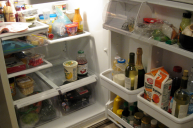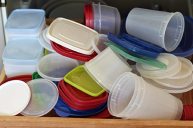When you finish one kitchen organization project, it often seems like there are three more left to do. Whether it's pantry organization or fridge organization, it can be hard to keep your DIY projects neat and tidy for one simple reason: everyone uses them! If your kitchen organization plans go awry after the first week of everyone in your home popping in and out of the refrigerator and cabinets, don't fret. Oftentimes keeping your refrigerator neat, from the lower shelves all the way to the refrigerator door, simply means using smart organizational techniques. There's no need to reinvent the wheel with a lazy Susan or clear plastic bins, though they work well for spacious refrigerators.
Videos by Wide Open Country
Inspired by a recent refrigerator organization post in Instagram by the Pioneer Woman, I knew the sorry state of my fridge was causing more frustration than necessary. No, I definitely didn't need to dig out a yogurt from the back of the upper shelf every morning before work. There had to be a way to organization mine like Ree Drummond organized hers!
So I hit the internet and searched for the best advice from people who organize professional kitchens. A note about my kitchen, it's all of three counter blocks and a stovetop. My refrigerator is smaller-than-average, so while I would love to be able to organize my deli meats in a resealable container for safe food storage and make the most of my fridge space with a cold brew coffee drip, there simply isn't enough room in my little refrigerator.
Here are the steps I learned and executed in my own kitchen during my recent Operation Organize Your Refrigerator. Note that I did not take any photos of the process — I am one of those wacky 'organize your life at 3:00 a.m.' night owls, so I didn't think photos of a bright fluorescent light did the job. I grabbed photos of exceptionally organized refrigerators from Instagram to provide real-life motivation.
Step 1: Get in the zone.
https://www.instagram.com/p/BdI_N-qnS70/?tagged=fridgeorganization
I don't know how you motivate yourself to do cleaning tasks that aren't necessarily urgent, but I have two surefire tricks. The first is to either pop on a record on my record player, and the second is to listen to a podcast or audiobook.
Keep your brain engaged and focused, and you'll find time slipping sweetly away as you move through these steps at lightning speed.
Step 2: Remove, reduce, and relabel.
https://www.instagram.com/p/BdxDgvgDnQJ/?tagged=fridgeorganization
I'm borrowing from the recycle slogan here, but this is the most important step in organizing your fridge! If you don't want to conquer this enormous step, then I recommend saving the whole project for another day.
Remove everything from your refrigerator (notice I didn't say freezer, I consider those two separate beasts!) and place them together in groups, organized by type. That means all of your salad dressings (and the things you use as salad dressings) go in one spot on your counter; all of the prepared foods and leftovers go in one spot; the shredded cheese sits with dairy; apples sit with fruits and vegetables, you get the idea.
Once your refrigerator is empty, you can clean it with a solution of white vinegar and water. I like using the natural approach to wiping up my fridge, but you can choose your own method to prevent cross-contamination from meat products.
Those piles you made of all of the food in your fridge? It's time to go through it. Check the expiration dates and throw out anything expired (here's a good list of things we often forget to check).
Step 3: Organize, organize, organize.
While everything is out and in precious piles, it's time to go through and relabel items. If you have homemade stock or yogurt in the refrigerator, relabel even though the date of expiration is the same. I like to remove items from their bulky original packaging in this step, but that often means having to add an expiration label. Grab a Sharpie, Post-Its, and tape.
If your refrigerator is big enough to do so, consider using plastic bins to group similar items together. Sandwich-making materials like deli meats and cheeses store well in their own space, and it means you don't have to waste one of your crisper drawers.
Step 4: Execute your strategy.
https://www.instagram.com/p/Bd5E3QMBJ00/?tagged=fridgeorganization
I learned that professional organizers like to organize refrigerators based on the temperature that food needs to be cooked to. It's not a bad strategy, but I've since tweaked it. Here are my organizational tactics.
- Upper shelves: Drinks, leftovers, dairy products, and ready-to-eat foods (sandwich materials, yogurt, applesauces, etc.)
- Lower shelves: Ingredients for cooking (homemade stocks, pre-chopped and washed vegetables, special ingredients for meal-planned dinners, etc.)
- Door: Condiments (The door is the warmest part of your refrigerator.)
- Crisper Drawers: I like to use one for vegetables and fruits that haven't been prepped in advance, while I store raw meat in the other. I don't like the idea of raw meat dripping into a drawer, so it earns its own spot in my refrigerator.
Step 5: Enjoy the fruits of your labor, if only for a few minutes.
Within one grocery trip, my refrigerator already lacked the perfectly clean, neat vibe that my late-night cleaning session produced. So as soon as you finish, take a deep breath and pat yourself on the back. Stretch, and open your refrigerator. Take in the sights and the clean smells because it won't last, and that's alright. It means hungry, happy people live there.




